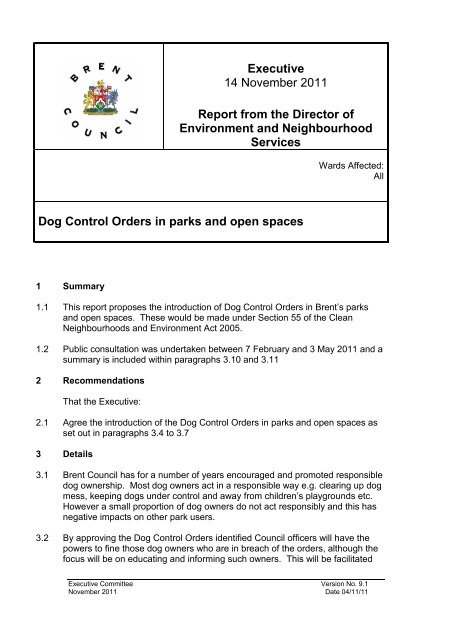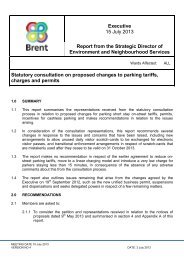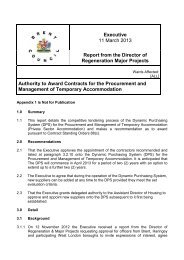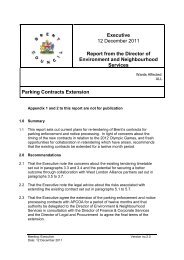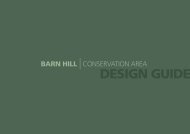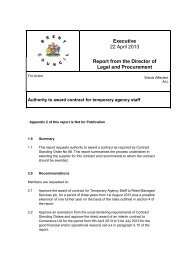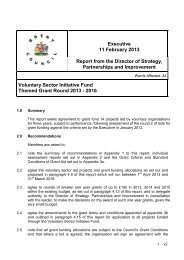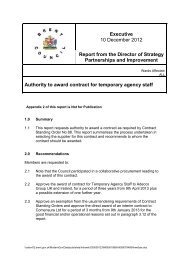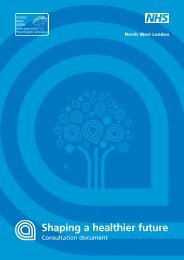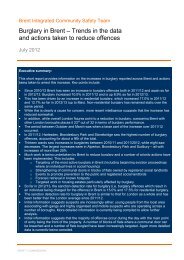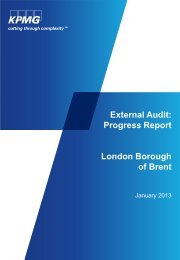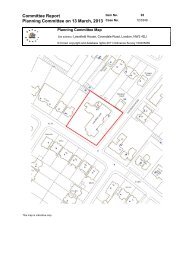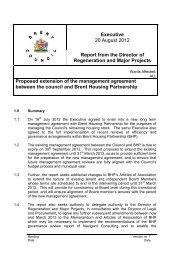Dog Control Orders PDF 101 KB - Brent Council
Dog Control Orders PDF 101 KB - Brent Council
Dog Control Orders PDF 101 KB - Brent Council
Create successful ePaper yourself
Turn your PDF publications into a flip-book with our unique Google optimized e-Paper software.
through a communications campaign which will include attending a series ofroadshows to be organised by the Animal Welfare team.3.3 Implementing the proposed <strong>Control</strong> <strong>Orders</strong> will not discriminate against dogs ordog owners but instead will balance the interests of those in charge of dogswith the interests of other users of parks who may be affected by the activitiesof dogs. Consideration has been given to the need for people, in particularchildren, to have access to dog free areas and areas where dogs are keptunder strict control. Consideration has also been given to the need for those incharge of dogs to have access to areas where they can exercise their dogswithout undue restrictions. The proposed measures are in no way seeking todisadvantage dog walkers; rather they aim to facilitate safe dog walking inappropriate open spaces within the borough. It is estimated that dogs will stillbe able to be walked “off lead” in over 90% of available green space in <strong>Brent</strong>.3.4 The <strong>Dog</strong> <strong>Control</strong> <strong>Orders</strong> will cover:o The maximum number of dogs which may be taken onto land:o Areas where dogs would be excludedo Areas where dogs are to be kept on leads.3.5 The maximum number of dogs which may be taken onto <strong>Brent</strong>’s parksand open spacesThe <strong>Dog</strong> <strong>Control</strong> <strong>Orders</strong> will restrict the maximum number of dogs to becontrolled by one person to six. It will be an offence for one person to be incharge of more than six dogs in any of the borough’s parks or open spaces.3.6 Areas where dogs would be excluded in <strong>Brent</strong>’s parks and open spacesThe <strong>Dog</strong> <strong>Control</strong> <strong>Orders</strong> designate a number of areas where dogs are notpermitted at any time. This applies to all playgrounds, multi-use games areas,tennis courts, netball courts and bowling greens. It will be an offence foranyone in charge of a dog to take the dog onto, or permit the dog to enter, or toremain in such designated areas. This does not apply to registered blindpeople, deaf people or other people with disabilities who make use of trainedassistance dogs.Areas where dogs are to be kept on leads in <strong>Brent</strong>’s parks and openspaces3.7 The <strong>Dog</strong> <strong>Control</strong> <strong>Orders</strong> designate areas where dogs must be kept on a lead.These include all 32 of the smaller/pocket parks listed in Appendix 1, areascontaining flower beds, walled gardens and other such areas where the walkingof dogs ‘off lead’ is deemed inappropriate. This does not apply to registeredblind people, deaf people or other people with disabilities who make use oftrained assistance dogs.3.8 Queen’s Park is included in the <strong>Orders</strong>. Queen’s Park is geographically withinthe London Borough of <strong>Brent</strong>, but is owned and managed by the Corporation ofLondon. The inclusion has been agreed with the Corporation of London at theirrequest and this agreement covers any subsequent revision of the <strong>Orders</strong> e.g.the maximum numbers of dogs that may be taken onto land.Executive CommitteeNovember 2011Version No. 9.1Date 04/11/11
4 Financial Implications4.1 The preparation of the <strong>Orders</strong> has been undertaken, and if agreed, they will beimplemented using existing <strong>Council</strong> budgets and existing <strong>Council</strong> officers toenforce the orders. Responsible dog ownership in parks is considered to havea positive financial implication to the <strong>Council</strong> and to society; converselyirresponsible dog ownership increases the costs of keeping parks clean. Asstated in paragraph 3.2 the focus is to educate dog owners about responsibledog ownership rather than issuing fines. As such, officers do not believe thatthe introduction of these orders will generate a significant level of income.5 Legal Implications5.1 It is proposed that the <strong>Council</strong> should introduce <strong>Dog</strong> <strong>Control</strong> <strong>Orders</strong> in parks asset out in paragraphs 3.4 to 3.7 of the Report to the Executive. The powerpermitting <strong>Dog</strong> <strong>Control</strong> <strong>Orders</strong> to be made is pursuant to Section 55 of CleanNeighbourhoods and Environment Act 2005 (“the 2005 Act“). The sectionstates:<strong>Dog</strong>sChapter 1<strong>Control</strong>s on <strong>Dog</strong>s<strong>Dog</strong> control orders55 Power to make dog control orders(1) A primary or secondary authority may in accordance with this Chaptermake an order providing for an offence or offences relating to the control ofdogs in respect of any land in its area to which this Chapter applies.(2) An order under subsection (1) is to be known as a “dog control order”.(3) For the purposes of this Chapter an offence relates to the control ofdogs if it relates to one of the following matters —(a)(b)(c)(d)fouling of land by dogs and the removal of dog faeces;the keeping of dogs on leads;the exclusion of dogs from land;the number of dogs which a person may take on to any land.(4) An offence provided for in a dog control order must be an offence whichis prescribed for the purposes of this section by regulations made by theappropriate person.5.2 Only Primary or Secondary authorities may make <strong>Dog</strong> <strong>Control</strong> <strong>Orders</strong>. Section58(1) (c) of the 2005 Act defines a “primary authority,” to include “a LondonBorough <strong>Council</strong>”. London Borough of <strong>Brent</strong> is therefore permitted to makesuch an Order[s].5.3 Section 55(3) provides for four potential types of <strong>Orders</strong> and the Report setsout that the <strong>Council</strong> seeks to utilise three of the four namely:-(i)the maximum number of dogs [Section 55(3)(d)]Executive CommitteeNovember 2011Version No. 9.1Date 04/11/11
(ii)(iii)areas where dogs would be excluded [Section 55(3)(c)]areas where dogs will be kept on leads Section 55(3)(b)]Therefore all three proposals contained in paragraphs 3.4-3 are permitted byvirtue of Section 55(3) as set out above.5.4 At the moment a variety of statutory provisions are used by the council topromote responsible dog ownership. These include the <strong>Dog</strong>s Act 1871 andthe Dangerous <strong>Dog</strong>s Act 1989. Some of these provisions are quite old, difficultfor residents to abide by and in some cases Magistrates to understand and/orapply. Further some of the older statutory provisions do not adequatelyaddress some of the current problems in this area.5.5 The proposal for London Borough of <strong>Brent</strong> to introduce <strong>Dog</strong> <strong>Control</strong> <strong>Orders</strong>will provide a more effective and transparent way of encouraging, promotingand if need be enforcing responsible dog ownership within the borough.5.6 As indicated in the Report to the Executive dated 14 th November 2011,Section 2(1) of the Local Government Act 2000 (the 2000 Act) provides localauthorities the power to do anything which they consider is to achieve one ormore of the following objects-(a)(b)(c)the promotion or improvement of the economic well-being of their area;the promotion or improvement of the social well-being of their area, andthe promotion or improvement of the environmental well-being of theirarea.5.7 Section 2(2) of the 2000 Act goes on to state that the power conferred inSubsection (1) above, may be exercised in relation to or for the benefit of –(a) the whole or any part of a local authority’s area, or(b) all or any persons resident or present in a local authority’s area5.8 It is therefore submitted that the introduction of the proposed <strong>Dog</strong> <strong>Control</strong><strong>Orders</strong> to London Borough of <strong>Brent</strong> will satisfy Section 2(1) (b) and (c)namely, the promotion or improvement of the social well-being andenvironmental well-being of the borough and its residents.6 Diversity Implications6.1 An Equality Impact Assessment was undertaken and is included at Appendix 2.No differential impact was identified except for possible economic impacts onprofessional dog walkers; and the clients of professional dog walkers. Clientsof professional dog walkers are often economically active people who areemployed elsewhere, but could include other dog owners who are disabled.Moreover the view of officers is that the proposals will enhance the use of parksand of some sports facilities for many people and will reduce environmentalproblems. The <strong>Dog</strong> <strong>Control</strong> <strong>Orders</strong> do not apply to trained assistance dogs andso disabled, blind and deaf dog owners with such dogs would not be affected.Executive CommitteeNovember 2011Version No. 9.1Date 04/11/11
7 Environmental Implications7.1 The introduction of the <strong>Dog</strong> <strong>Control</strong> <strong>Orders</strong> is expected to enhance responsibledog ownership. It is expected that the specified recreational and sporting areasfrom which dogs will be excluded will be cleaner. Smaller parks and otherspecified areas where dogs are to be kept on leads should enhance theenjoyment of visits by other park users. Similarly, problems with large groupsof dogs in parks should be reduced.Background PapersAppendix 1 - Location of areas where dogs are to be kept on a lead.Appendix 2 - Equality Impact Assessment: <strong>Dog</strong> <strong>Control</strong> <strong>Orders</strong>.Contact OfficersSue HarperDirector of Environment and Neighbourhood ServicesNeil DaviesStrategy and Service Development Manager, Sports and ParksExecutive CommitteeNovember 2011Version No. 9.1Date 04/11/11


